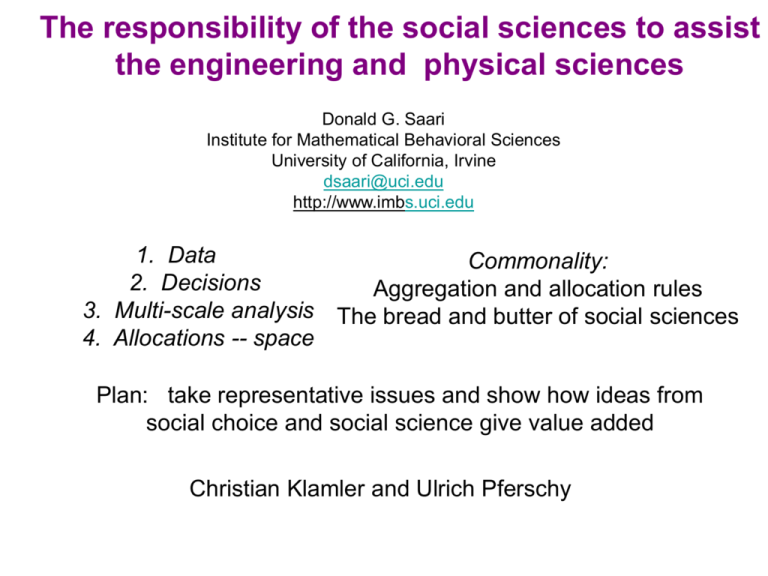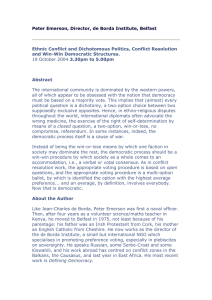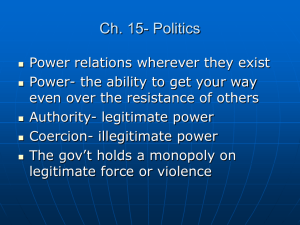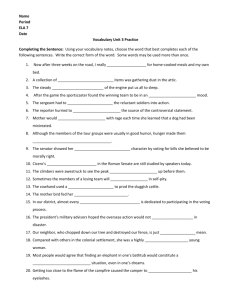What causes this theorem? - University of California, Irvine
advertisement

The responsibility of the social sciences to assist
the engineering and physical sciences
Donald G. Saari
Institute for Mathematical Behavioral Sciences
University of California, Irvine
dsaari@uci.edu
http://www.imbs.uci.edu
1. Data
Commonality:
2. Decisions
Aggregation and allocation rules
3. Multi-scale analysis The bread and butter of social sciences
4. Allocations -- space
Plan: take representative issues and show how ideas from
social choice and social science give value added
Christian Klamler and Ulrich Pferschy
Nonparametric statistics
A
B
C
A
23 21 19
7
24 25 20 ranks 8
2
18 17 22
Kruskal Wallis 17
B
Subjective
C
Deanna Haunsperger
5 3
JASA 1992
9 4
1 6
E.g., K-W is the
Borda method
15 13
So, A>B>C
So, she could
Other methods:
A>B>C A>C>B transfer results
from voting to
A>B>C
statistics
Here, data defines a profile with 27
“voters”;
vote with some positional method
Voting results
5 ABCD
7 ACBD
9 ADBC
4 BACD
7 BCAD
9 BDAC
8 CBAD
11 CDAB
8 DBAC
10 DCAB
Plurality ranking: A>B>C>D with 21:20:19:18 tallies
Drop any alternative, and outcome flips to reflect D>C>B>A
Drop any two alternative, and outcome flips to reflect A>B>C>D
My dictionary results:
r any number of candidates specify any ranking for each subset of candidate
specify a positional voting rule for each subset of candidates
In almost all cases, an example can be created!
Main exception, Borda Count!
Using my dictionary of voting outcomes,
Haunsperger characterized the outcome of all of these nonparametric rules
Example:
The Kruskal-Wallis Test is bad, very bad
Of all possible non-parametric methods, the KW is by far the best!
With Anna Bargagliotti,
using my approach toward voting theory to understand and
characterize all consequences of all non-parametric methods
Choice of non-parametric rule no longer is “subjective!”
Power indices:
pi = Σ λS(v(S+i) OR, cost allocation, etc.
v(S))
v(S+i) - v(S)
A. Laruelle and V. Merlin -- used my dictionary, found Shapley
value is identified with Borda Count
D. Saari and K. Sieberg
Decisions: often by parts
criteria become “voters”
Social choice, voting theory shows why “bad decisions”
can easily be made
Already know that information is lost when using “parts,”
and it occurs in engineering, etc.
Newhealth
questions,
Sociology,
policy, etc. Multi-scale analysis
New relationships
Part with the parts
Newton’s Headache
?
Where can we
find
structure, a
Nano
simpler
systems
multiscale
system to
analyze?
Biological systems have the first level of organization at the
nanoscale. Proteins, DNA, RNA, ion channels are nanoscale
systems that leverage molecular interactions to perform specific
tasks. Integrated nano-bio systems have emerged as strong
candidates for single molecule detection, genomic sequencing, and
the harnessing of naturally occurring biomotors. Design of integrated
nano-bio devices can benefit from simulation, just as the design of
microfluidic devices have benefited. Currently a large stumbling
block is the lack of simulation methods capable of handling
nanoscale physics, device level physics, and the coupling of the two.
Sen’s Theorem
Shirt
Conflict: Individual rights vs societal welfare
•
Lost
information
Inputs: Preferences are
Note:
Emphasis
is on Pairwise decisions!
transitive,
no restriction
•
•
•
•
•
Outputs: No societal cycles
Procedure: Pareto
Minimal Liberalism: At least
each of two agents are decisive,
each over assigned pairs
Conclusion: No procedure
exists
Why? What causes this
theorem?
1 A>B>C
2 B>C>A
{A,B} {B, C} {A, C}
1 AB
2 --
BC
BC
AB BC
-CA
CA
Cycle!!
Multi-scale analysis
Micro
Macro
What can go right, what can go wrong?
Many
things can
go wrong!
One example: Path dependency
Rather than optimality, or establishing connections
between scales, it is possible for the outcome to
reflect the order in which elements are analyzed
rather than the micro behavior
Path dependency - simple example
10 A>B>C>D>E>F
Everyone prefers C>D>E>F
10 B>C>D>E>F>A
Pairwise comparisons?
Not apparent
10 C>D>E>F>A>B
“Severingare
effect”
Depending on the path optimal decisions
made, anything can be
selected!
To select F:
Physics? Chemistry? Electronics
D
D
Calculus; line integrals
C
E
B
C
A
B
A
F
Unanimous or two-thirds
support: Very strong
“evidence” that F is
“optimal”
from here
F
to here
can depend on path
•
•
•
•
•
•
Inputs: Preferences are
Sen
transitive, no restriction
Outputs: No societal cycles
Procedure: Pareto
Minimal Liberalism: At least
each of two agents are
decisive, each over assigned
pairs
Conclusion: No procedure
exists
Why? What causes this
Compatibility conditions
theorem?
All elements are needed
some combinations are not
compatible
compensative
Macro
Add natural conditions on rule;
e.g., maybe some macro effects
determined by one force
unanimity type conditions
Result: A Sen-type conclusion;
Impossibility
Message: Beware; evidence may
appear to provide overwhelming
support about the existence of a
connection, a result, etc., yet it can
be wrong
Positive results are being
developed
Creating all possible Sen examples
1. Start with desired societal outcome; e.g, AB, BC, CD, DA and BC,
CE, EA, AB. Assign to each agent.
1
2
Outcome
AB
AB
AB
BC
BC
BC
CD DA CE EA
CD DA CE EA
CD DA CE EA
Strong negative externality
1:
CEDAB;
2: BCEDA
For everyone
over each cycle!
2. For each cycle and each agent, assign another agent to be
decisive over a pair; e.g., AB to 1, and BC to 2
3. Now find associated transitive preferences for agents (here, just
reverse blocked off pairwise ranking).
Individual rights; or imposing on others
Similar kinds of
Dysfunctional
effects for multi-scale
society?
analysis
Over the last week, we have explored a small but
important part of “the incredible complexity of the social
sciences”
and,
in particular,
economics
A lesson
learned
is that
guidance,
direction, and
possible resolutions for these many areas come from
examining what happens in the “simpler” social choice
or voting setting
A lesson learned is that the same concepts extend to
almost all science areas.
These are very important issues; join in the analysis of
them, particularly the extension of social choice to other
areas
A lesson Lillian and I learned is the beauty of this area,
the incredible hospitality of all, starting with Christian2
and extends and includes so many others!
Our thanks to all for a most memorable visit!





